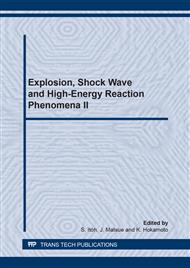p.60
p.68
p.74
p.80
p.86
p.92
p.101
p.109
p.114
Computational Simulation of Underwater Shock Wave Propagation Using Smoothed Particle Hydrodynamics
Abstract:
Underwater shock wave phenomenon is applied to various fields such as manufacturing, food processing and medical equipment, and has been investigated with many experiment and numerical analysis. Because of low heat generation and possibility of downsizing of the device which generates shock wave, an application of shock wave induced by gap discharge in food processing has been studied recently. In this study, an ellipsoidal vessel filled with water is modeled in 2D and a computational simulation of underwater shock wave propagation is implemented using Smoothed Particle Hydrodynamics. Then, the computational result is compared with an experimental one and have a good agreement with the experimental one in qualitative. In the simulation, focusing of pressure wave, which is characteristic phenomenon of elliptical vessel, is observed.
Info:
Periodical:
Pages:
86-91
Citation:
Online since:
July 2013
Price:
Сopyright:
© 2014 Trans Tech Publications Ltd. All Rights Reserved
Share:
Citation:


